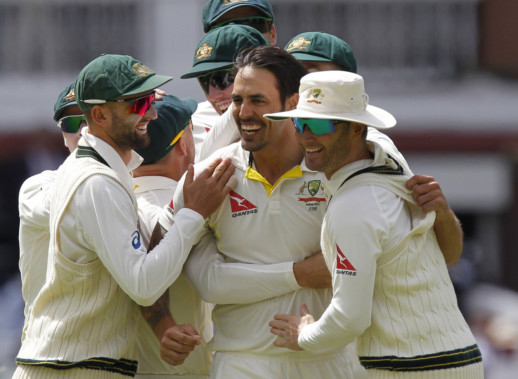
Mitchell Johnson has exerted a psychological hold over England’s batsmen ever since he sorted out his own mental approach to cricket.
He has learnt to deal with the pressures of the international game much better than when he struggled in England in 2009. He is twice the bowler now than he was then, because his game has control and aggression. It is why he has a hold over a lot of batsmen all over the world, not just Englishmen.
When I speak to players from other countries, they all say how ridiculously well he is bowling at the moment. It is hard for teams to break that hold, especially when he is in form. But you have to embrace the challenge and ignore the defeatist thoughts.
When you retire from cricket you want to be able to say you scored runs against the best teams in the toughest situations. So who cares if he is bowling well. England have to relish the challenge. I always wanted to test myself against the best: Glenn McGrath, Shane Warne and Muttiah Muralitharan. Scoring runs against them is what I am proud of.
Our guys certainly have the talent to stand up to him, and I hope they take the attack to him. Facing Johnson is not just about intimidation. It is a really high-grade, emotional experience. It is as intense as it gets in our sport. You know that one bad move could get you hurt or get you out.
It is like a little inner psychological battle with yourself. Not only are you having to apply your skill levels to the moment, but you also have to be aware of the game situation.
Against the top bowlers, the best players take the pressure off by just watching the ball out of the hand. But with Johnson’s action and the way he runs up to the wicket, it is hard to track the ball, because his hands are everywhere.
It can be intimidating when he bowls short at a right-hander, because the trajectory of the delivery is into your left shoulder and left ear. With fielders at leg gully and short leg it is like being in a mini arena. You can hook Johnson, but I just tried to leave as many balls as possible.
You know he is only going to bowl in three or four-over spells. So if he bowls a short ball, get out of the way. I also used to believe that the best place to face a fast bowler like him was from the non-striker’s end, so try to get off strike. If he bowled anything short and wide or over-pitched, I would be looking to hit it. No bowler likes being hit for four, including the best.
He is not as threatening when he is not swinging the ball. That is the key thing England need to remember. As a right-handed batsman, if he is not swinging the ball, then you can leave him or get out of the way of a lot of his deliveries, because they are not hitting the wickets.
But even when the ball is not swinging, he is very dangerous to left-handers. He is always attacking their stumps. It is why he and Mitchell Starc complement each other so well. Starc hits the stumps of the right-handers. Johnson bowls fast and aggressively in short bursts, whereas Starc can bowl for longer periods and swings the ball back into the right-handers.
Josh Hazlewood is a quality, accurate bowler. It is a very strong attack.
Before the series started, I had concerns Gary Ballance was going to struggle against these guys. He had a good year last summer but I felt problems could arise when he faced speeds of more than 85mph. I batted with him in the fifth Ashes Test in Sydney and I noticed slight issues with his technique against Johnson.
Eighteen months later, unfortunately these have not improved quite enough, so he rightly had to be taken out of the firing line. Ultimately though, this experience can improve him. He will work on those issues and come back an ever better player.
Ian Bell is a wonderful batsman and is now in his rightful position at three. He is struggling at the moment. But every batsman has those periods. The problem in England is that, once you have played more than 100 Tests, patience wears thin. Very few England players go on into their late 30s. We always seem to want to move older players on and give others an opportunity.
Now Bell finds himself in that position and, if he fails to score runs, people will say his career is finished. It is wrong and unfair. He needs support right now and positive people around him.
Bell played at Edgbaston 10 years ago and there are similarities with that great Ashes Test. We went into that game on the back of a hiding at Lord’s, too. But we arrived at Edgbaston still thinking we could beat Australia. We collectively made the decision to attack Australia, go real hard at them and to whack their bowlers. We had the team and the batting order that was able to go out there and deliver what we talked about in the team meetings.
It is going to be harder for England to do that this week with a few struggling for form, but the intentions have to be the same. The addition of Jonny Bairstow will bring a natural lift, because he is in such good form. But the gap between county and Test cricket is huge; it is a mountain.
I hope he does well, because I like Jonny. I had great times with him in the England dressing room. He is a lovely lad and hopefully he can fight fire with fire this week and that spreads to the rest of the team.
— The Telegraph Group Limited, London 2015












